Biological Anthropology Report: Comparing Bonobos and Chimpanzees
VerifiedAdded on 2021/04/16
|7
|1757
|46
Report
AI Summary
This Biological Anthropology report analyzes two articles: "Bonobo Sex and Society" by Frans de Waal and "Almost Human" by Mary Roach, comparing the social structures and behaviors of Bonobos and Chimpanzees. The report highlights the differences in their social hierarchies, with Bonobos exhibiting female dominance and a more peaceful society compared to the male-dominated and often violent chimpanzee communities. It explores the role of sexual behavior in Bonobo society and contrasts it with the hunting behaviors of chimpanzees, including tool use and group hunting strategies. The report discusses the implications of these findings for understanding human evolution and the potential evolutionary links between primate behaviors and human characteristics, such as violence and social organization, emphasizing the importance of matriarchal societies and the role of sex in conflict resolution and social bonding. The author reflects on the new information learned about the similarities in the social structure of the Bonobos and the contrast with the Chimpanzees.

Running head: Biological Anthropology
Biological Anthropology
Name of the Student
Name of the University
Author Note
Biological Anthropology
Name of the Student
Name of the University
Author Note
Paraphrase This Document
Need a fresh take? Get an instant paraphrase of this document with our AI Paraphraser
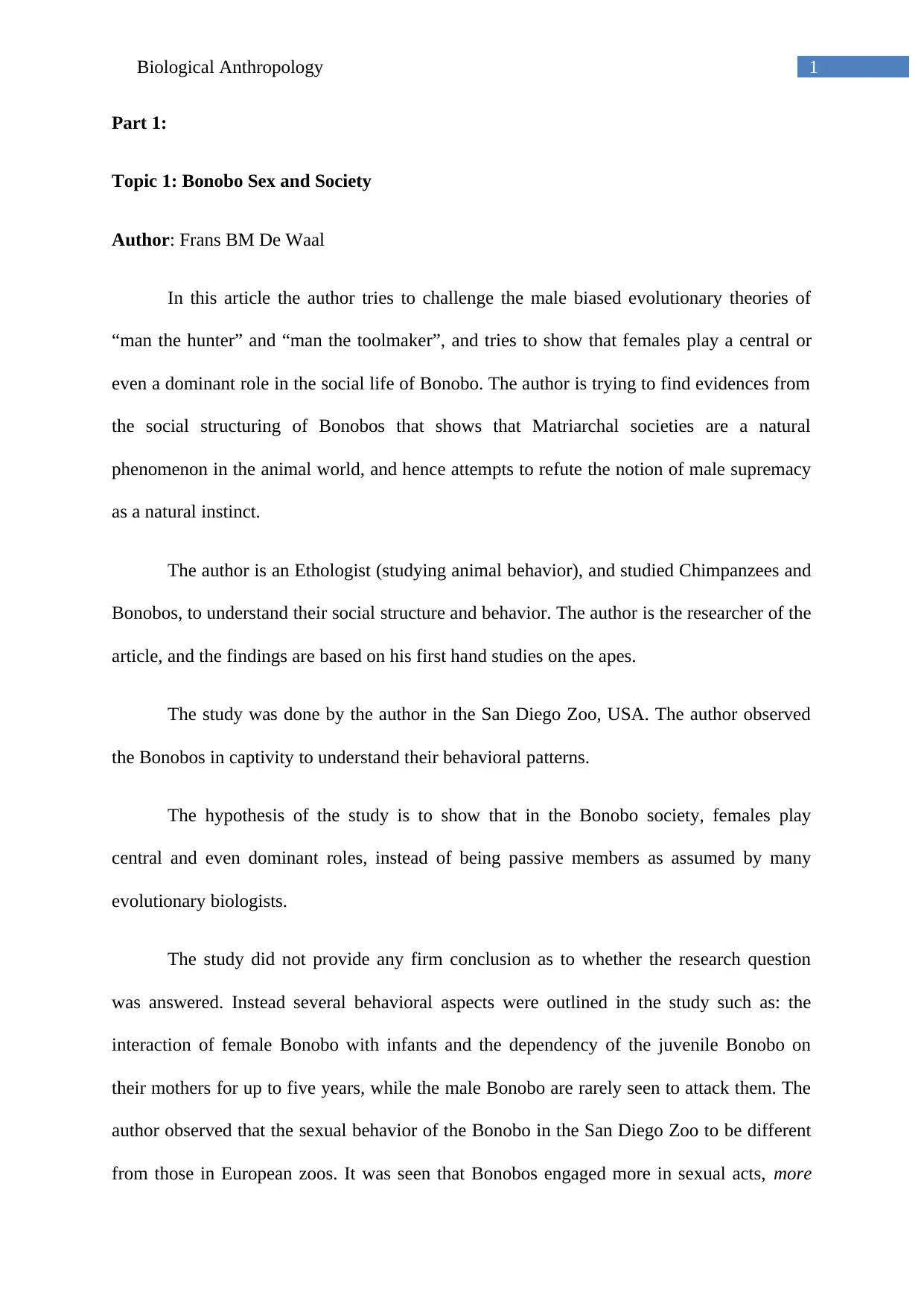
1Biological Anthropology
Part 1:
Topic 1: Bonobo Sex and Society
Author: Frans BM De Waal
In this article the author tries to challenge the male biased evolutionary theories of
“man the hunter” and “man the toolmaker”, and tries to show that females play a central or
even a dominant role in the social life of Bonobo. The author is trying to find evidences from
the social structuring of Bonobos that shows that Matriarchal societies are a natural
phenomenon in the animal world, and hence attempts to refute the notion of male supremacy
as a natural instinct.
The author is an Ethologist (studying animal behavior), and studied Chimpanzees and
Bonobos, to understand their social structure and behavior. The author is the researcher of the
article, and the findings are based on his first hand studies on the apes.
The study was done by the author in the San Diego Zoo, USA. The author observed
the Bonobos in captivity to understand their behavioral patterns.
The hypothesis of the study is to show that in the Bonobo society, females play
central and even dominant roles, instead of being passive members as assumed by many
evolutionary biologists.
The study did not provide any firm conclusion as to whether the research question
was answered. Instead several behavioral aspects were outlined in the study such as: the
interaction of female Bonobo with infants and the dependency of the juvenile Bonobo on
their mothers for up to five years, while the male Bonobo are rarely seen to attack them. The
author observed that the sexual behavior of the Bonobo in the San Diego Zoo to be different
from those in European zoos. It was seen that Bonobos engaged more in sexual acts, more
Part 1:
Topic 1: Bonobo Sex and Society
Author: Frans BM De Waal
In this article the author tries to challenge the male biased evolutionary theories of
“man the hunter” and “man the toolmaker”, and tries to show that females play a central or
even a dominant role in the social life of Bonobo. The author is trying to find evidences from
the social structuring of Bonobos that shows that Matriarchal societies are a natural
phenomenon in the animal world, and hence attempts to refute the notion of male supremacy
as a natural instinct.
The author is an Ethologist (studying animal behavior), and studied Chimpanzees and
Bonobos, to understand their social structure and behavior. The author is the researcher of the
article, and the findings are based on his first hand studies on the apes.
The study was done by the author in the San Diego Zoo, USA. The author observed
the Bonobos in captivity to understand their behavioral patterns.
The hypothesis of the study is to show that in the Bonobo society, females play
central and even dominant roles, instead of being passive members as assumed by many
evolutionary biologists.
The study did not provide any firm conclusion as to whether the research question
was answered. Instead several behavioral aspects were outlined in the study such as: the
interaction of female Bonobo with infants and the dependency of the juvenile Bonobo on
their mothers for up to five years, while the male Bonobo are rarely seen to attack them. The
author observed that the sexual behavior of the Bonobo in the San Diego Zoo to be different
from those in European zoos. It was seen that Bonobos engaged more in sexual acts, more
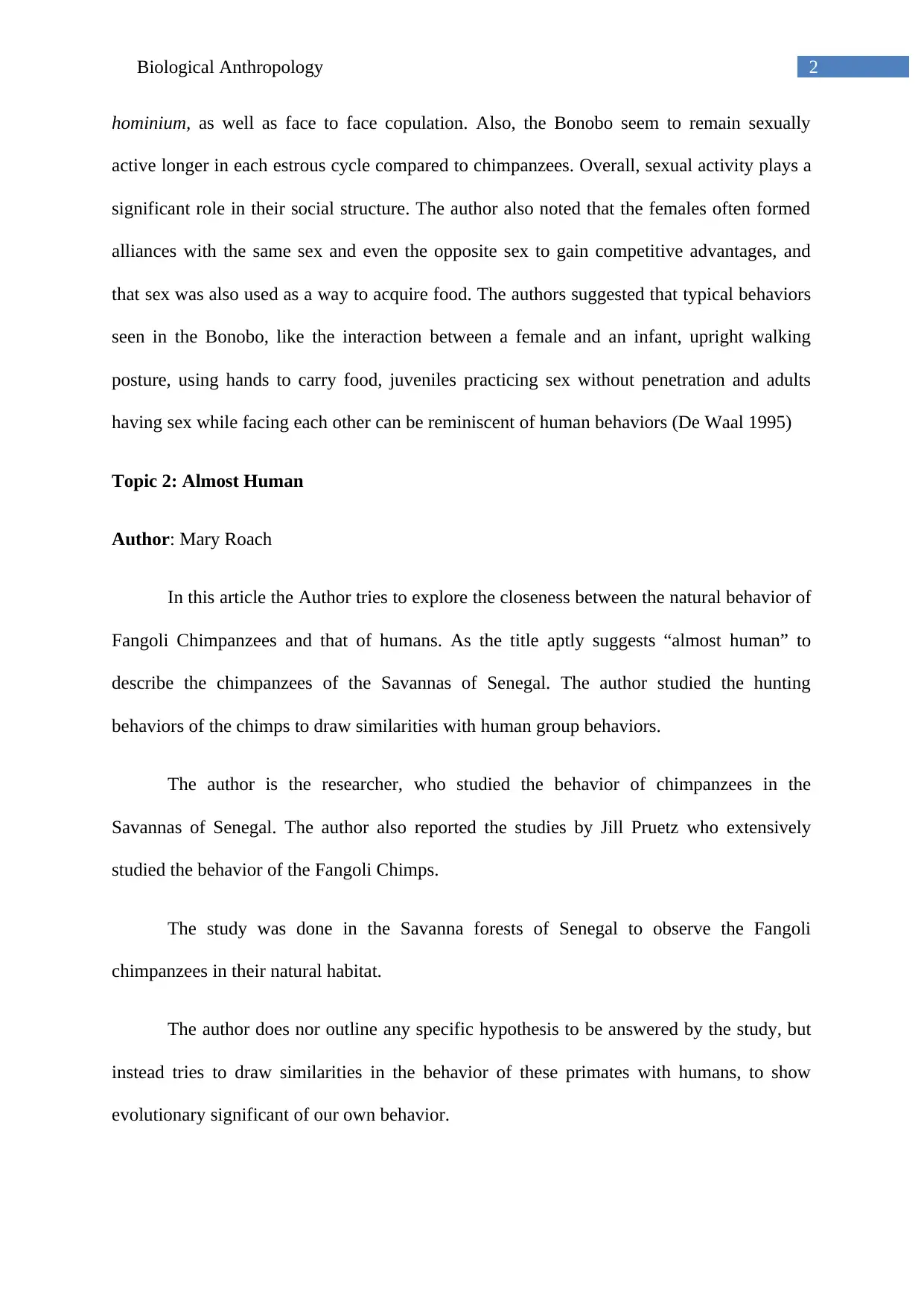
2Biological Anthropology
hominium, as well as face to face copulation. Also, the Bonobo seem to remain sexually
active longer in each estrous cycle compared to chimpanzees. Overall, sexual activity plays a
significant role in their social structure. The author also noted that the females often formed
alliances with the same sex and even the opposite sex to gain competitive advantages, and
that sex was also used as a way to acquire food. The authors suggested that typical behaviors
seen in the Bonobo, like the interaction between a female and an infant, upright walking
posture, using hands to carry food, juveniles practicing sex without penetration and adults
having sex while facing each other can be reminiscent of human behaviors (De Waal 1995)
Topic 2: Almost Human
Author: Mary Roach
In this article the Author tries to explore the closeness between the natural behavior of
Fangoli Chimpanzees and that of humans. As the title aptly suggests “almost human” to
describe the chimpanzees of the Savannas of Senegal. The author studied the hunting
behaviors of the chimps to draw similarities with human group behaviors.
The author is the researcher, who studied the behavior of chimpanzees in the
Savannas of Senegal. The author also reported the studies by Jill Pruetz who extensively
studied the behavior of the Fangoli Chimps.
The study was done in the Savanna forests of Senegal to observe the Fangoli
chimpanzees in their natural habitat.
The author does nor outline any specific hypothesis to be answered by the study, but
instead tries to draw similarities in the behavior of these primates with humans, to show
evolutionary significant of our own behavior.
hominium, as well as face to face copulation. Also, the Bonobo seem to remain sexually
active longer in each estrous cycle compared to chimpanzees. Overall, sexual activity plays a
significant role in their social structure. The author also noted that the females often formed
alliances with the same sex and even the opposite sex to gain competitive advantages, and
that sex was also used as a way to acquire food. The authors suggested that typical behaviors
seen in the Bonobo, like the interaction between a female and an infant, upright walking
posture, using hands to carry food, juveniles practicing sex without penetration and adults
having sex while facing each other can be reminiscent of human behaviors (De Waal 1995)
Topic 2: Almost Human
Author: Mary Roach
In this article the Author tries to explore the closeness between the natural behavior of
Fangoli Chimpanzees and that of humans. As the title aptly suggests “almost human” to
describe the chimpanzees of the Savannas of Senegal. The author studied the hunting
behaviors of the chimps to draw similarities with human group behaviors.
The author is the researcher, who studied the behavior of chimpanzees in the
Savannas of Senegal. The author also reported the studies by Jill Pruetz who extensively
studied the behavior of the Fangoli Chimps.
The study was done in the Savanna forests of Senegal to observe the Fangoli
chimpanzees in their natural habitat.
The author does nor outline any specific hypothesis to be answered by the study, but
instead tries to draw similarities in the behavior of these primates with humans, to show
evolutionary significant of our own behavior.
⊘ This is a preview!⊘
Do you want full access?
Subscribe today to unlock all pages.

Trusted by 1+ million students worldwide
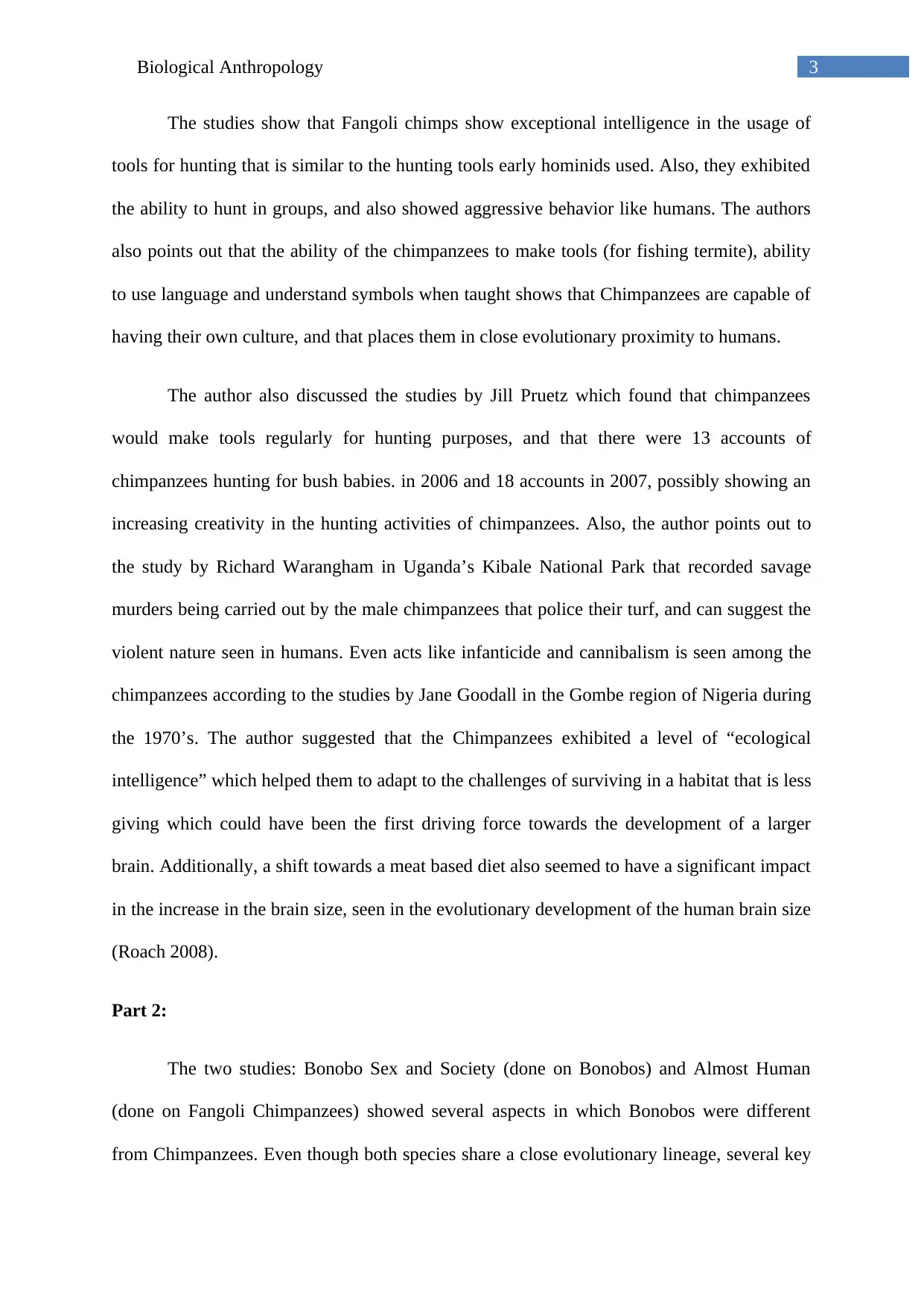
3Biological Anthropology
The studies show that Fangoli chimps show exceptional intelligence in the usage of
tools for hunting that is similar to the hunting tools early hominids used. Also, they exhibited
the ability to hunt in groups, and also showed aggressive behavior like humans. The authors
also points out that the ability of the chimpanzees to make tools (for fishing termite), ability
to use language and understand symbols when taught shows that Chimpanzees are capable of
having their own culture, and that places them in close evolutionary proximity to humans.
The author also discussed the studies by Jill Pruetz which found that chimpanzees
would make tools regularly for hunting purposes, and that there were 13 accounts of
chimpanzees hunting for bush babies. in 2006 and 18 accounts in 2007, possibly showing an
increasing creativity in the hunting activities of chimpanzees. Also, the author points out to
the study by Richard Warangham in Uganda’s Kibale National Park that recorded savage
murders being carried out by the male chimpanzees that police their turf, and can suggest the
violent nature seen in humans. Even acts like infanticide and cannibalism is seen among the
chimpanzees according to the studies by Jane Goodall in the Gombe region of Nigeria during
the 1970’s. The author suggested that the Chimpanzees exhibited a level of “ecological
intelligence” which helped them to adapt to the challenges of surviving in a habitat that is less
giving which could have been the first driving force towards the development of a larger
brain. Additionally, a shift towards a meat based diet also seemed to have a significant impact
in the increase in the brain size, seen in the evolutionary development of the human brain size
(Roach 2008).
Part 2:
The two studies: Bonobo Sex and Society (done on Bonobos) and Almost Human
(done on Fangoli Chimpanzees) showed several aspects in which Bonobos were different
from Chimpanzees. Even though both species share a close evolutionary lineage, several key
The studies show that Fangoli chimps show exceptional intelligence in the usage of
tools for hunting that is similar to the hunting tools early hominids used. Also, they exhibited
the ability to hunt in groups, and also showed aggressive behavior like humans. The authors
also points out that the ability of the chimpanzees to make tools (for fishing termite), ability
to use language and understand symbols when taught shows that Chimpanzees are capable of
having their own culture, and that places them in close evolutionary proximity to humans.
The author also discussed the studies by Jill Pruetz which found that chimpanzees
would make tools regularly for hunting purposes, and that there were 13 accounts of
chimpanzees hunting for bush babies. in 2006 and 18 accounts in 2007, possibly showing an
increasing creativity in the hunting activities of chimpanzees. Also, the author points out to
the study by Richard Warangham in Uganda’s Kibale National Park that recorded savage
murders being carried out by the male chimpanzees that police their turf, and can suggest the
violent nature seen in humans. Even acts like infanticide and cannibalism is seen among the
chimpanzees according to the studies by Jane Goodall in the Gombe region of Nigeria during
the 1970’s. The author suggested that the Chimpanzees exhibited a level of “ecological
intelligence” which helped them to adapt to the challenges of surviving in a habitat that is less
giving which could have been the first driving force towards the development of a larger
brain. Additionally, a shift towards a meat based diet also seemed to have a significant impact
in the increase in the brain size, seen in the evolutionary development of the human brain size
(Roach 2008).
Part 2:
The two studies: Bonobo Sex and Society (done on Bonobos) and Almost Human
(done on Fangoli Chimpanzees) showed several aspects in which Bonobos were different
from Chimpanzees. Even though both species share a close evolutionary lineage, several key
Paraphrase This Document
Need a fresh take? Get an instant paraphrase of this document with our AI Paraphraser
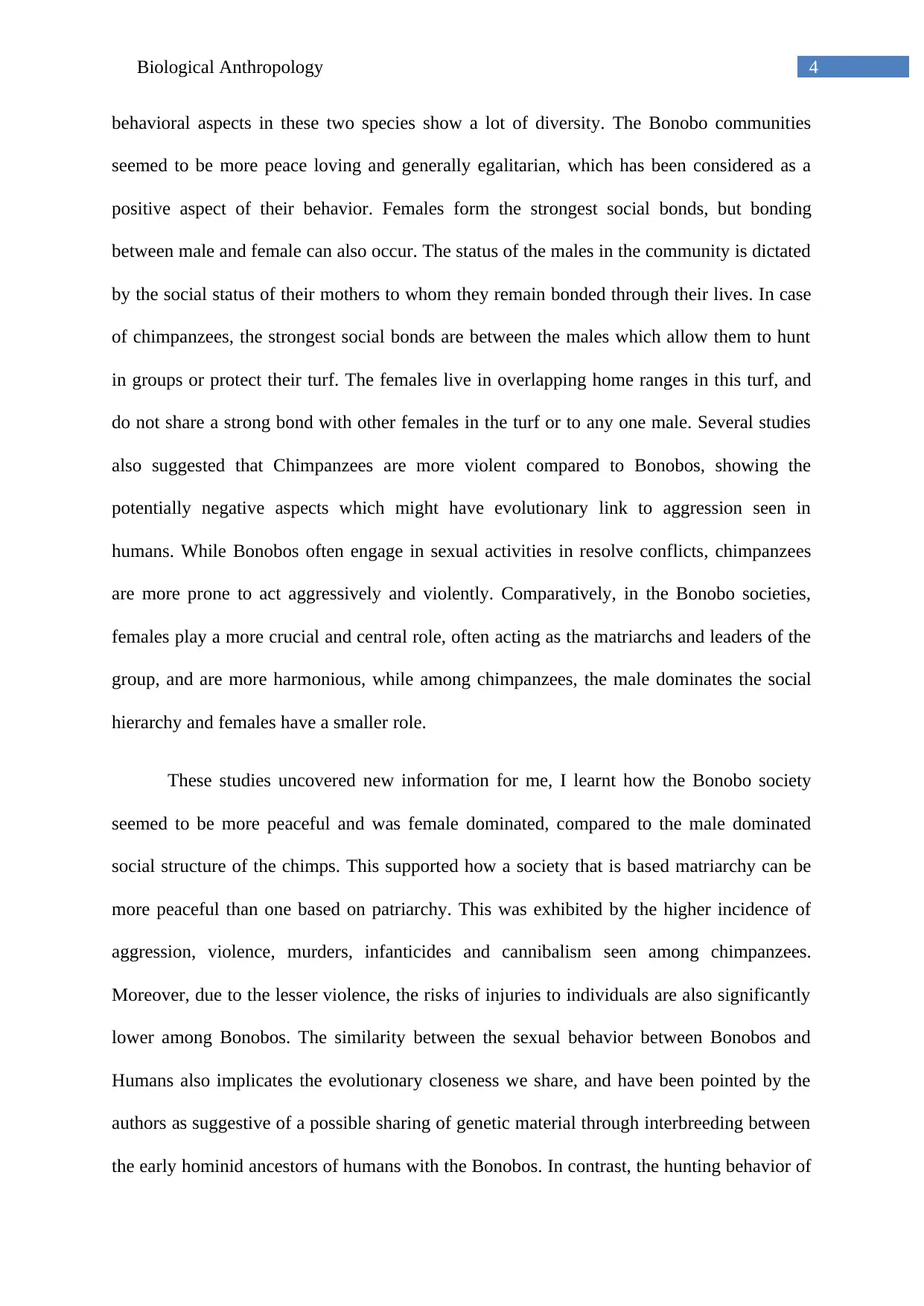
4Biological Anthropology
behavioral aspects in these two species show a lot of diversity. The Bonobo communities
seemed to be more peace loving and generally egalitarian, which has been considered as a
positive aspect of their behavior. Females form the strongest social bonds, but bonding
between male and female can also occur. The status of the males in the community is dictated
by the social status of their mothers to whom they remain bonded through their lives. In case
of chimpanzees, the strongest social bonds are between the males which allow them to hunt
in groups or protect their turf. The females live in overlapping home ranges in this turf, and
do not share a strong bond with other females in the turf or to any one male. Several studies
also suggested that Chimpanzees are more violent compared to Bonobos, showing the
potentially negative aspects which might have evolutionary link to aggression seen in
humans. While Bonobos often engage in sexual activities in resolve conflicts, chimpanzees
are more prone to act aggressively and violently. Comparatively, in the Bonobo societies,
females play a more crucial and central role, often acting as the matriarchs and leaders of the
group, and are more harmonious, while among chimpanzees, the male dominates the social
hierarchy and females have a smaller role.
These studies uncovered new information for me, I learnt how the Bonobo society
seemed to be more peaceful and was female dominated, compared to the male dominated
social structure of the chimps. This supported how a society that is based matriarchy can be
more peaceful than one based on patriarchy. This was exhibited by the higher incidence of
aggression, violence, murders, infanticides and cannibalism seen among chimpanzees.
Moreover, due to the lesser violence, the risks of injuries to individuals are also significantly
lower among Bonobos. The similarity between the sexual behavior between Bonobos and
Humans also implicates the evolutionary closeness we share, and have been pointed by the
authors as suggestive of a possible sharing of genetic material through interbreeding between
the early hominid ancestors of humans with the Bonobos. In contrast, the hunting behavior of
behavioral aspects in these two species show a lot of diversity. The Bonobo communities
seemed to be more peace loving and generally egalitarian, which has been considered as a
positive aspect of their behavior. Females form the strongest social bonds, but bonding
between male and female can also occur. The status of the males in the community is dictated
by the social status of their mothers to whom they remain bonded through their lives. In case
of chimpanzees, the strongest social bonds are between the males which allow them to hunt
in groups or protect their turf. The females live in overlapping home ranges in this turf, and
do not share a strong bond with other females in the turf or to any one male. Several studies
also suggested that Chimpanzees are more violent compared to Bonobos, showing the
potentially negative aspects which might have evolutionary link to aggression seen in
humans. While Bonobos often engage in sexual activities in resolve conflicts, chimpanzees
are more prone to act aggressively and violently. Comparatively, in the Bonobo societies,
females play a more crucial and central role, often acting as the matriarchs and leaders of the
group, and are more harmonious, while among chimpanzees, the male dominates the social
hierarchy and females have a smaller role.
These studies uncovered new information for me, I learnt how the Bonobo society
seemed to be more peaceful and was female dominated, compared to the male dominated
social structure of the chimps. This supported how a society that is based matriarchy can be
more peaceful than one based on patriarchy. This was exhibited by the higher incidence of
aggression, violence, murders, infanticides and cannibalism seen among chimpanzees.
Moreover, due to the lesser violence, the risks of injuries to individuals are also significantly
lower among Bonobos. The similarity between the sexual behavior between Bonobos and
Humans also implicates the evolutionary closeness we share, and have been pointed by the
authors as suggestive of a possible sharing of genetic material through interbreeding between
the early hominid ancestors of humans with the Bonobos. In contrast, the hunting behavior of
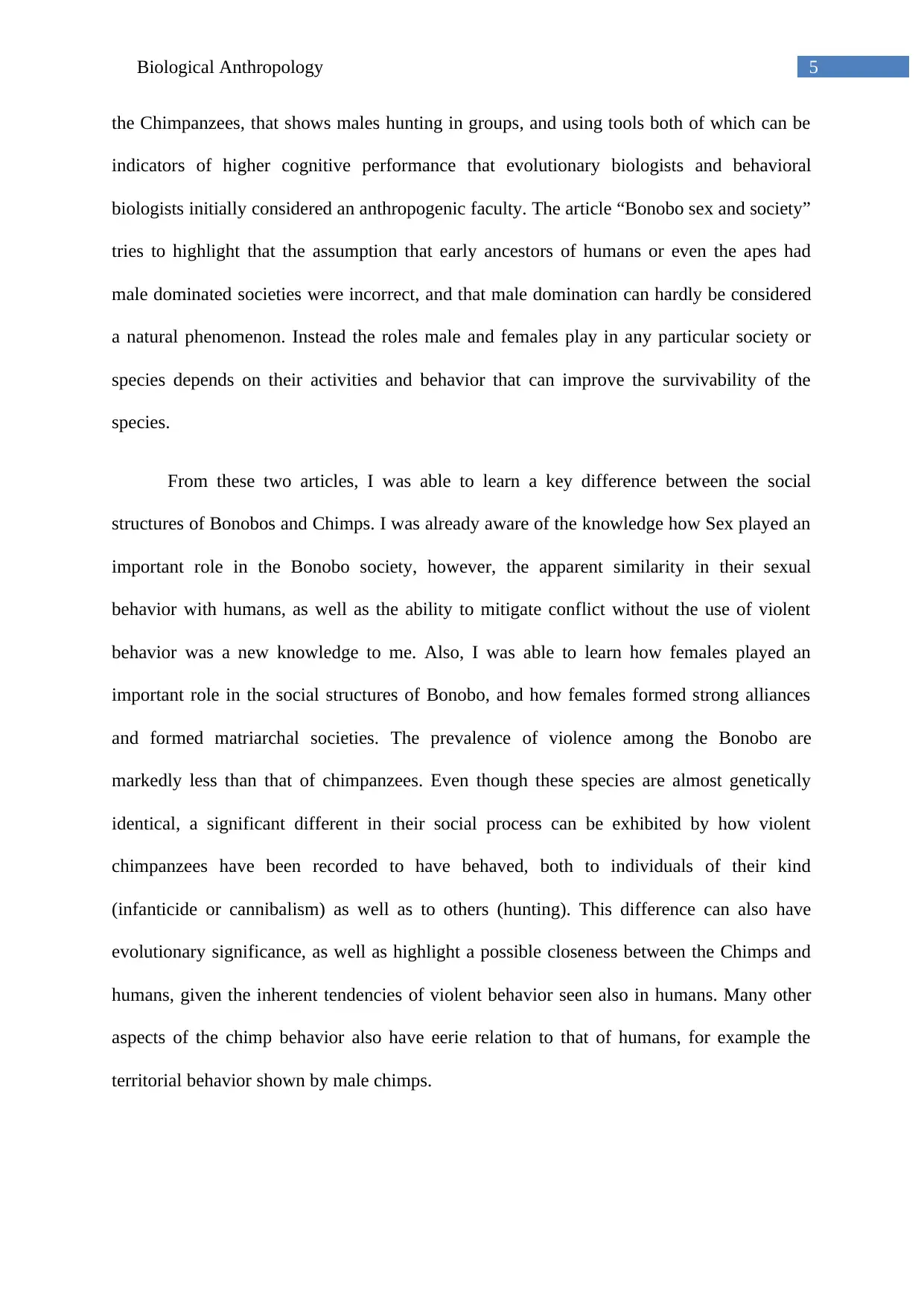
5Biological Anthropology
the Chimpanzees, that shows males hunting in groups, and using tools both of which can be
indicators of higher cognitive performance that evolutionary biologists and behavioral
biologists initially considered an anthropogenic faculty. The article “Bonobo sex and society”
tries to highlight that the assumption that early ancestors of humans or even the apes had
male dominated societies were incorrect, and that male domination can hardly be considered
a natural phenomenon. Instead the roles male and females play in any particular society or
species depends on their activities and behavior that can improve the survivability of the
species.
From these two articles, I was able to learn a key difference between the social
structures of Bonobos and Chimps. I was already aware of the knowledge how Sex played an
important role in the Bonobo society, however, the apparent similarity in their sexual
behavior with humans, as well as the ability to mitigate conflict without the use of violent
behavior was a new knowledge to me. Also, I was able to learn how females played an
important role in the social structures of Bonobo, and how females formed strong alliances
and formed matriarchal societies. The prevalence of violence among the Bonobo are
markedly less than that of chimpanzees. Even though these species are almost genetically
identical, a significant different in their social process can be exhibited by how violent
chimpanzees have been recorded to have behaved, both to individuals of their kind
(infanticide or cannibalism) as well as to others (hunting). This difference can also have
evolutionary significance, as well as highlight a possible closeness between the Chimps and
humans, given the inherent tendencies of violent behavior seen also in humans. Many other
aspects of the chimp behavior also have eerie relation to that of humans, for example the
territorial behavior shown by male chimps.
the Chimpanzees, that shows males hunting in groups, and using tools both of which can be
indicators of higher cognitive performance that evolutionary biologists and behavioral
biologists initially considered an anthropogenic faculty. The article “Bonobo sex and society”
tries to highlight that the assumption that early ancestors of humans or even the apes had
male dominated societies were incorrect, and that male domination can hardly be considered
a natural phenomenon. Instead the roles male and females play in any particular society or
species depends on their activities and behavior that can improve the survivability of the
species.
From these two articles, I was able to learn a key difference between the social
structures of Bonobos and Chimps. I was already aware of the knowledge how Sex played an
important role in the Bonobo society, however, the apparent similarity in their sexual
behavior with humans, as well as the ability to mitigate conflict without the use of violent
behavior was a new knowledge to me. Also, I was able to learn how females played an
important role in the social structures of Bonobo, and how females formed strong alliances
and formed matriarchal societies. The prevalence of violence among the Bonobo are
markedly less than that of chimpanzees. Even though these species are almost genetically
identical, a significant different in their social process can be exhibited by how violent
chimpanzees have been recorded to have behaved, both to individuals of their kind
(infanticide or cannibalism) as well as to others (hunting). This difference can also have
evolutionary significance, as well as highlight a possible closeness between the Chimps and
humans, given the inherent tendencies of violent behavior seen also in humans. Many other
aspects of the chimp behavior also have eerie relation to that of humans, for example the
territorial behavior shown by male chimps.
⊘ This is a preview!⊘
Do you want full access?
Subscribe today to unlock all pages.

Trusted by 1+ million students worldwide

6Biological Anthropology
References:
De Waal, Frans BM. "Bonobo sex and society." Scientific american 272, no. 3 (1995): 82-88.
Roach, Mary. "Almost human." National Geographic 213, no. 4 (2008): 124-145.
References:
De Waal, Frans BM. "Bonobo sex and society." Scientific american 272, no. 3 (1995): 82-88.
Roach, Mary. "Almost human." National Geographic 213, no. 4 (2008): 124-145.
1 out of 7
Your All-in-One AI-Powered Toolkit for Academic Success.
+13062052269
info@desklib.com
Available 24*7 on WhatsApp / Email
![[object Object]](/_next/static/media/star-bottom.7253800d.svg)
Unlock your academic potential
Copyright © 2020–2025 A2Z Services. All Rights Reserved. Developed and managed by ZUCOL.